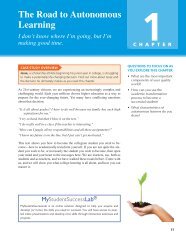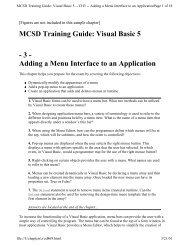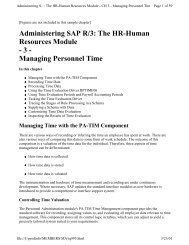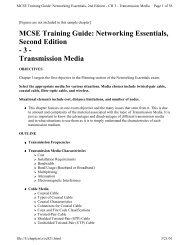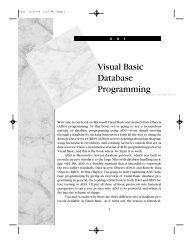SOCIAL PROBLEMS: A Down-to-Earth Approach, 8/e
SOCIAL PROBLEMS: A Down-to-Earth Approach, 8/e
SOCIAL PROBLEMS: A Down-to-Earth Approach, 8/e
You also want an ePaper? Increase the reach of your titles
YUMPU automatically turns print PDFs into web optimized ePapers that Google loves.
KEY TERMS<br />
Case study, 17<br />
Common sense, 16<br />
Control group, 18<br />
Documents, 19<br />
Experiment, 18<br />
Experimental group, 18<br />
Field study (or Participant<br />
observation), 18<br />
Generalize, 18<br />
Interview, 18<br />
FOR REFERENCE<br />
Methods (Research methods or<br />
Methodology), 17<br />
Objective condition, 6<br />
Observation, 19<br />
Participant observation (or Field<br />
study), 18<br />
Personal trouble, 4<br />
Population, 18<br />
Power, 6<br />
Questionnaire, 19<br />
Random sample, 18<br />
Contexts. Published by the American Sociological<br />
Association, this magazine summarizes sociological research<br />
in an informal and informative manner. Many <strong>to</strong>pics<br />
are covered, not just social problems.<br />
Social Problems. Official journal of the Society for the<br />
Study of Social Problems, the organization for sociologists<br />
and other social scientists who are concerned about social<br />
THINKING CRITICALLY ABOUT CHAPTER 1<br />
1. Select a social problem and apply the sociological<br />
imagination <strong>to</strong> it.<br />
• What makes this situation a social problem?<br />
(Explain how it matches the definition of a social<br />
problem outlined in this chapter.)<br />
• What are the values of the people who are involved<br />
in this social problem? (Be sure <strong>to</strong> look at both sides<br />
of the problem, not just the one that matches your<br />
ideas of what is right or wrong.)<br />
• What social forces shaped the parties’ points of<br />
view?<br />
Research design, 17<br />
Sample, 17<br />
Social problem, 6<br />
Sociological imagination (or<br />
sociological perspective), 3<br />
Sociological perspective, 4<br />
Sociology, 14<br />
Structured interview, 18<br />
Subjective concern, 6<br />
Survey, 17<br />
Unstructured interview, 18<br />
problems. Available in most college libraries, the journal<br />
presents research and theorizing on social problems.<br />
Mother Jones. A magazine with radical and muckraking reporting<br />
that covers controversial aspects of social problems.<br />
The Public Interest. A journal whose less-sensational coverage<br />
balances the approach of Mother Jones.<br />
• What objective conditions changed <strong>to</strong> bring this<br />
problem <strong>to</strong> the surface?<br />
2. Who do you think is winning the battle between the<br />
proabortion and antiabortion activists? Why? Use the<br />
court decisions cited in this chapter <strong>to</strong> support your<br />
answer.<br />
3. Select a social problem. Which research methods do<br />
you think would be most appropriate for studying this<br />
social problem? Why?<br />
4. Do you think that sociologists have a responsibility <strong>to</strong><br />
take sides on social problems? Why or why not?<br />
THINKING CRITICALLY ABOUT CHAPTER 1 23



